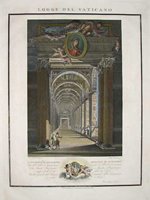 After architect-artist Donato Bramante (1444-1514) recommended that Pope Julius II give Raphael the task of finishing Bramante's own decoration of the Vatican apartments, in 1513 Pope Leo X (Giovanni di Lorenzo de Medici, from Florence) commissioned Raffaello Sanzio da Urbino (1483-1520) to decorate the Loggia.
After architect-artist Donato Bramante (1444-1514) recommended that Pope Julius II give Raphael the task of finishing Bramante's own decoration of the Vatican apartments, in 1513 Pope Leo X (Giovanni di Lorenzo de Medici, from Florence) commissioned Raffaello Sanzio da Urbino (1483-1520) to decorate the Loggia.
During the last two years of his life Raphael supervised a team of workers to paint his fresco designs on the tall pilasters (pillars), arches and ceiling vaults. A testament to his genius, Raphael created a High Renaissance masterpiece of classical design. (At left is a perspective view looking through the Loggia towards the residence entrance.) Raphael's inclusion of 'grotesque' strips of themed illustrations was imitated by neoclassical designers during the following centuries.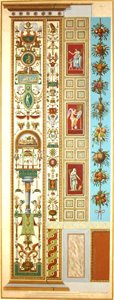
250 years after their completion Pope Clement XIII appointed eminent architects, draughtsmen and engravers to record Raphael's beautiful 16th century fresco designs with their imaginative grotesques of flowers and fruit, wildlife, gods and graces of mythology, and fine architectural design, including simulated marble. Where pilaster frescoes were illegible from weather damage, design elements from Raphael's Vatican tapestries were substituted. Printed from copperplates these engravings were published in Rome between 1772 and 1776 as Le Logge di Raffaele nel Vaticano (The Loggia by Raphael at the Vatican). An enormous project, each tall pilaster fresco was drawn and then engraved onto two large copper plates. Each joined-pair of printed engravings measures 105 x 44cm (41 inches tall x 17.25 inches wide).
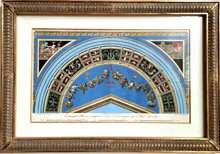
With titles elegantly inscribed at the base, biblical illustrations in the upper corners of the ceiling arches were embellished by beautiful grotesque arches of classical architectural details and delicate garlands of fruit and flowers. The striking later gouache watercolour echoes the depth of colour that was created originally by painting on wet plaster to create the frescoes.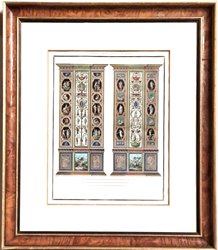
The above original grand engravings c1776 of Raphael's pilaster frescoes were considered of such importance, that ten years later they were re-engraved smaller, in pairs, for wider circulation. The below examples of exquisitely fine engravings were published not only in Rome, but also in Paris by Pierre-Philippe Choffard in 1813.
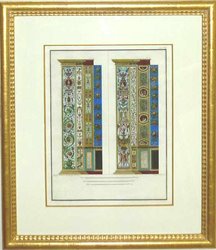
The elegant classical beauty of Raphael frescoes is timeless.
Of a quality more often seen in the Museums of Europe, these beautiful centuries-old engravings of Raphael Vatican Loggia frescoes are available from Antique Print Club on Mt Nimmel in Neranwood, 1 hour south of Brisbane in Queensland, Australia 4213.
They can be previewed on this AntiquePrintClub.com website at /Products/Antique-Prints/Classical-Antique-Design/Wall-and-Ceiling-Painted-Frescoes.aspx